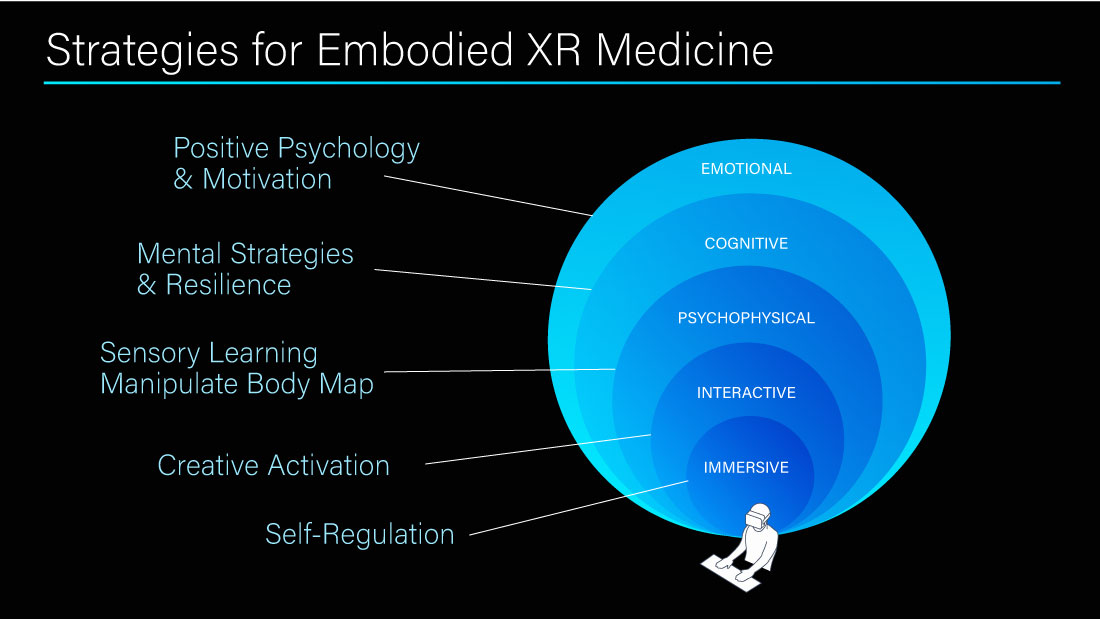Strategies for Embodied XR Medicine
Anatomy of Experience
Howard Rose
Immersive digital technologies like VR/AR are opening doors to entirely new modalities for health, wellness, and therapy. The number of VR applications for physical and mental health is growing fast, as well as clinical evidence of efficacy.
As more practitioners and patients adopt VR in healthcare, it seems helpful to have a conceptual model of how VR works and specific strategies to apply it. I a model of Embodied Digital Medicine, to map the five Virtual Super Human Powers (Immersion; Interaction; Psychophysical; Cognition; Emotion) to approaches and health outcomes.
Note: If you’re not into virtual health, please don’t run away. This post focuses on embodied health, but there are takeaways here that can be easily applied to education, product design, arts, and many other areas.
First stop, let’s define Embodiment? Virtual Embodiment is the feeling of being inside a virtual body and having a degree of control over that body. Mel Slater has helped define and plumb the depths of embodiment with a career of thoughtful and thought-provoking research. Slater describes three components that comprise the subjective experience of embodiment: sense of self-location, sense of agency, sense of ownership. Highly recommend visiting Slater’s Event Lab site.
OK, now let’s peel this onion – Digital Superpowers meets Health Strategies:
Strategies
Layer 1: Immersion Strategies
Immersion is the sensation of being physically inside the virtual space, and that space feels real. Immersion is an absolute requirement to achieve the sensation of Embodiment in a virtual space. The phenomenon of Immersion happens without any conscious effort; immersion is preconscious.
Immersion is where the Embodied health story starts. VR enables us to separate from the external world, the limitations of our bodies, the stresses that normally limit us. Immersion enables strategies around emotion regulation and attention that can apply to pain reduction, stress and anxiety control, and any condition where poor emotion control can trigger other symptoms, such as COPD.
Immersion is where Embodied Medicine starts. It’s table stakes for the everything else.
Layer 2: Interactive Strategies
Once people are immersed in a virtual world, the first question they ask is “what do I do here?” VR capitalizes on our natural human urge to be active with therapeutic strategies of play, body learning, movement, mental gymnastics. Movement and interactive strategies can be applied to many conditions including: physical therapy, pain reduction, build resilience and sense of control, and retrain neurological and body pathways.
Layer 3: Psychophysical Strategies
VR is a psychophysical experience. Meaning when we experience motion or other sensations in the virtual world, we feel them in our body. Flying in VR we feel the sense of being high up; riding in a virtual car our bodies feel the motion. When it’s not respected, the psychophysicality of VR can lead to uncomfortable side effects and motion sickness. But with care the body/mind link is fertile ground for therapeutic approaches that engage sensory learning and manipulate the internal body map. These strategies apply to physical and mental rehab, movement therapy, and engage people who are withdrawn or suffer isolation.
Layer 4: Cognitive Strategies
We step up to apply the higher power of cognition for Embodied Medicine. Therapeutic Cognitive Strategies in VR include building skills, manipulating cognitive load, training flexibility and resilience, and opportunities for personal insight. These approaches can be harnessed to improve cognitive behavioral therapy, mindfulness training, and treatment compliance.
Layer 5: Emotional Strategies
At the top level, VR enables us to access emotional levels like no other media. This is based on all the other levels. Emotional Strategies include: Motivation Empowerment, Positive Psychology. They can target Stress, Anxiety, Depression.
Tips to Make the Strategies Work for You
Use Multiple Strategies: Just as the 5 Super Power layers are interrelated and complementary, solutions that incorporate multiple strategic layers will reap multiple benefits. Each layer can enhance the others, e.g strong psychophysical engagement increases the sense of immersion. Create a positive feedback loop that spirals your way to success.
Device Agnostic: This model is not a blueprint for what technology to apply to each strategy. There’s a lot of room to get creative at every level. The key to success and the way to avoid the technology-in-search-of-a-solution trap is to start with the outcome and work back to the technology solution to deliver it.
Multimodal Implementations: Weave together different physical and mental modes of deliver for a stronger outcome. For example, a creative activity that engages sensory learning and mental strategies is going to yield more than the sum of each part on its own.
Please share your thoughts on this post. Let me know if you have been able to put these strategies to use as an XR developer or a consumer.
© 2021 Howard Rose, all rights reserved
Discover more from Howard Rose
Subscribe to get the latest posts sent to your email.



